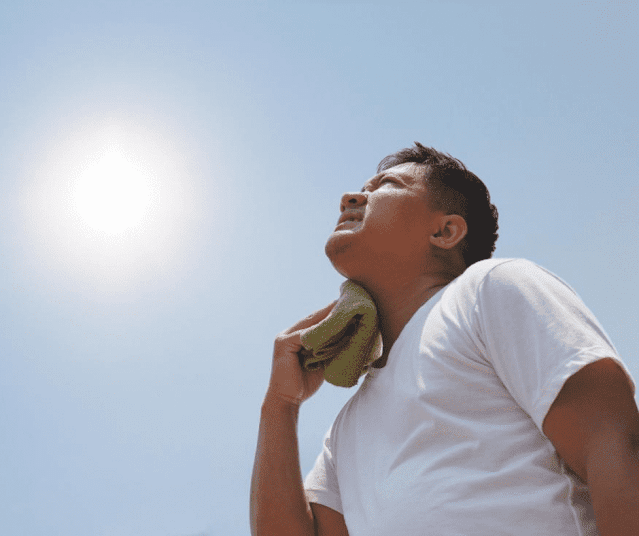Sudden weakness, fever, nausea, or even vomiting after resting under the scorching sun is a condition familiar to many. Sunstroke or overheating of the body can occur not only during exposure to heat but even after a few hours,
Since ancient times, the sun has brought warmth to the world, gives people a hormone of joy and invaluable vitamin D, but sometimes it can become an insidious enemy. We are talking about those cases when someone does not take into account the rules of safe stay under hot rays. And then the heavenly body strikes back, which is called the solar one.
What is sunstroke?
This is a type of heatstroke that occurs when exposed to direct sunlight. Sunstroke occurs when a person's body heats up excessively. And although the body is able to regulate the temperature, responding to its increase by increased sweating, sometimes a failure can occur in this process. In this case, overheating causes vasodilation in the head, which increases blood flow to them.Causes of sunstroke in adults
Most often, this is a long stay in hot weather under the sun at its zenith, from about 11 to 16 o'clock in the afternoon. Therefore, you can get hit, both on the beach and in the garden or in training. Under the influence of direct sunlight, the head heats up, and parts of the brain overheat. All this leads to an increase in blood pressure, which threatens the rupture of small vessels and disruption of the central nervous system and vital functions of the body.Factors that increase your risk of sunstroke:
* excess weight;
* cardiovascular diseases;
* alcohol intoxication and smoking;
* too tight (synthetic) and tight clothing;
* lack of protective headgear;
* neurological problems;
* elderly age;
* calm and stuffy weather;
* taking antidepressants.
Sunstroke symptoms in adults
There are three degrees of sunstroke:Light - the victim experiences weakness, headache, nausea. At the same time, his pulse is quickened, and his pupils are dilated.
Average - a person's temperature rises sharply, a headache, nausea, dizziness, and tinnitus appear, gait becomes unstable, darkening and flies appear in the eyes, loss of consciousness and nosebleeds are possible.
Heavy- develops suddenly. The victim's face becomes hot and red, then turns pale. The skin of the face and mucous membranes acquires a grayish-blue or cyanotic dark hue, which indicates a violation of blood circulation. The body temperature rises to 41 - 42 ° C. Against this background, the pulse weakens and becomes more frequent, convulsions, dizziness, hallucinations, delirium, loss of consciousness, or even coma may appear.
Sunstroke treatment in adults
The main treatment is to cool the victim and eliminate dehydration. In this case, it is important to provide primary care correctly.- The most important thing is to carry the person into the shade, raise his legs, put any cold object on his forehead, free the chest from squeezing clothes, the man needs to unfasten his belt and tie, -- It is also important to examine the victim's belongings, perhaps he suffers from diabetes mellitus and has hypoglycemia. This fact can be confirmed, for example, by a diabetic's book.
With this option, you urgently need to crumble sugar or chocolate into his mouth. You can also dissolve 5 to 6 teaspoons of sugar in water and pour it gently into your mouth with a spoon. If a person feels bad, but he does not complain about anything, I earnestly ask you not to give him nitroglycerin, so as not to complicate the person's condition and the work of the ambulance doctors. This is a vasodilator drug, which must be used strictly as directed.
In case of sunstroke, experts also advise giving a person cool mineral water or replacing it with plain water by adding salt and sugar at the tip of a knife. This will help restore the water-salt balance. You can also cool your body with damp towels or cold water bags applied to your armpits, groin, and neck. In case of loss of consciousness, ammonia should be brought to the patient's nose.
Diagnostics
Symptoms of sunstroke can be partly similar to a stroke, severe drug allergies, acute bacterial infection, or complications of thyroid disease, so it is important to call an ambulance as soon as possible for a correct diagnosis. It is possible that the victim will need to be examined by a resuscitator, cardiologist, neurologist, or other specialists.Modern methods of treatment
People with signs of sunstroke require specialized medical care, especially when it comes to elderly patients and those who suffer from cardiovascular pathologies or chronic diseases. If necessary, the ambulance team will give the patient artificial respiration. To restore the water-salt balance, a solution of sodium chloride is injected intravenously.For heart failure and asphyxia, subcutaneous injections of CNS stimulants are used. To normalize blood pressure, antihypertensive and diuretic drugs are used. In case of severe sunstroke, the patient is admitted to a hospital where a full range of resuscitation measures will be performed, including intravenous drips, intubation, cardiac stimulation, administration of diuretics, and oxygen therapy.
Emergency doctors recommend seeking medical help even with mild sunstrokes.
“It is important that the doctor examines the victim and gives his recommendations,” they say. - If doctors are convinced that the person's condition does not cause concern, then he can refuse hospitalization. This will help avoid any unpleasant consequences and will eliminate chronic diseases that increase the risk of sunstroke.
For anyone who has suffered from sunstroke, doctors advise avoiding physical activity.
within a few days, otherwise, it may recur. The consequences of sunstroke in the future can be violations of some functions of the brain, headaches, various neurological conditions, problems with coordination of movements, vision, and diseases of the cardiovascular system.
Prevention of sunstroke in adults at home
Here are some tips to help you avoid sunstroke:* Do not be in the heat under the open sun, especially from 11 to 17 o'clock in the afternoon - otherwise, use sun umbrellas or hide in the shade;
* Wear light clothing made from natural fabrics, hats;
* Monitor the water balance, drink mineral water, weakly brewed green tea, or natural diluted juices;
* Avoid fatty and protein foods and alcohol in the heat.
Popular questions and answers
Can you die from sunstroke?In severe cases, asphyxia with extensive cerebral hemorrhage, acute cardiovascular failure, and cardiac arrest may develop.
“A person can die from sunstroke if they do not receive primary care,”- Therefore, in case of any suspicion of sunstroke, it is important to call a doctor as soon as possible, and to properly cool the victim before the ambulance arrives.
For which category of adults is sunstroke dangerous in the first place?
- The most vulnerable are the elderly because due to their age, the natural thermoregulation of the body is poorly functioning. Patients with obesity, hypertension, diabetes, pregnant women, smokers, and those who like to drink outdoors are also at risk, the experts emphasize.
Related Articles:
* How a woman looks younger than her age

